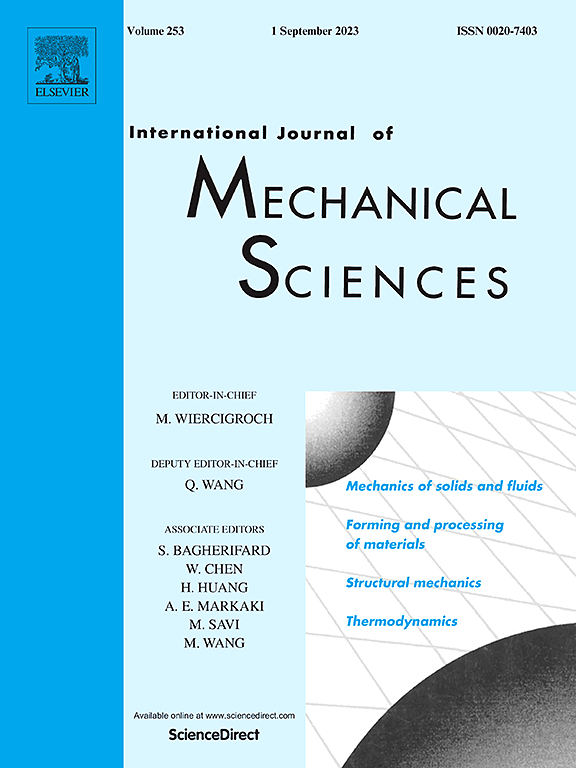Modeling, analytical solutions and experiment of a mechanical-transmission type energy harvester
IF 7.1
1区 工程技术
Q1 ENGINEERING, MECHANICAL
International Journal of Mechanical Sciences
Pub Date : 2025-07-11
DOI:10.1016/j.ijmecsci.2025.110594
引用次数: 0
Abstract
In metro rail transit, wireless sensor networks play a vital role in monitoring. With the increasing application of the steel-spring floating slab track (SFST), harvesting track vibration energy to power underground wireless sensors has emerged as an innovative and eco-friendly solution. In this paper, a practical mechanical-transmission type energy harvester employing a helical multi-stage structure (MEHHM) is designed for the SFST. A comprehensive theoretical model with mechanical parameters considered is established under harmonic excitation as well as within the vehicle-SFST-MEHHM coupled system. A reconstructed harmonic balance (RHB) method assisted by the two-point tracking method is employed to solve the semi-analytical periodic responses of the transmission, enabling an efficient tracing of solution curves. Results show that the mechanical parameters have obvious influence on the dynamic responses, output performance and transmission stability of the MEHHM. Experimental results show a good agreement with the simulation. Under the harmonic displacement excitation of 4 mm and 2 Hz, the average output power can reach a high level of 33.73 W. Under the floating slab displacement excitation at 60 km/h train speed, application tests are conducted to verify the MEHHM’s output capacity. Overall, our work advances the theoretical modeling and analysis of energy harvesting for SFSTs, offering new insights into the research framework for rail transit energy harvesting.

一种机械传动式能量采集器的建模、解析解和实验
在地铁轨道交通中,无线传感器网络在监控中起着至关重要的作用。随着钢弹簧浮板轨道(SFST)的应用越来越广泛,收集轨道振动能量为地下无线传感器供电已成为一种创新且环保的解决方案。本文为SFST设计了一种实用的机械传动式多级螺旋结构能量采集器。建立了考虑力学参数的车辆- sfst - mehhm耦合系统谐波激励下的综合理论模型。采用重构谐波平衡法(RHB)辅助两点跟踪法求解输电系统的半解析周期响应,实现了求解曲线的高效跟踪。结果表明,机械参数对电机的动态响应、输出性能和传动稳定性有明显的影响。实验结果与仿真结果吻合较好。在4 mm、2 Hz的谐波位移激励下,平均输出功率可达到33.73 W的高水平。在列车速度为60km /h的浮板位移激励下,进行了应用试验,验证了MEHHM的输出能力。总的来说,我们的工作推进了SFSTs能量收集的理论建模和分析,为轨道交通能量收集的研究框架提供了新的见解。
本文章由计算机程序翻译,如有差异,请以英文原文为准。
求助全文
约1分钟内获得全文
求助全文
来源期刊

International Journal of Mechanical Sciences
工程技术-工程:机械
CiteScore
12.80
自引率
17.80%
发文量
769
审稿时长
19 days
期刊介绍:
The International Journal of Mechanical Sciences (IJMS) serves as a global platform for the publication and dissemination of original research that contributes to a deeper scientific understanding of the fundamental disciplines within mechanical, civil, and material engineering.
The primary focus of IJMS is to showcase innovative and ground-breaking work that utilizes analytical and computational modeling techniques, such as Finite Element Method (FEM), Boundary Element Method (BEM), and mesh-free methods, among others. These modeling methods are applied to diverse fields including rigid-body mechanics (e.g., dynamics, vibration, stability), structural mechanics, metal forming, advanced materials (e.g., metals, composites, cellular, smart) behavior and applications, impact mechanics, strain localization, and other nonlinear effects (e.g., large deflections, plasticity, fracture).
Additionally, IJMS covers the realms of fluid mechanics (both external and internal flows), tribology, thermodynamics, and materials processing. These subjects collectively form the core of the journal's content.
In summary, IJMS provides a prestigious platform for researchers to present their original contributions, shedding light on analytical and computational modeling methods in various areas of mechanical engineering, as well as exploring the behavior and application of advanced materials, fluid mechanics, thermodynamics, and materials processing.
 求助内容:
求助内容: 应助结果提醒方式:
应助结果提醒方式:


